This guide is ideal for homeowners, renters, and interior designers looking to enhance their bathroom spaces with plain bathroom mirrors. Whether you're embarking on a full bathroom renovation or simply updating an existing setup, this guide provides valuable insights for anyone interested in modern, functional, and minimalist mirror designs. DIY enthusiasts will benefit from the detailed mirror installation instructions, while those seeking to maintain their mirrors in pristine condition will find the maintenance tips particularly useful. Additionally, this guide is perfect for anyone looking to gain a deeper understanding of bathroom mirror options and how to integrate them seamlessly into various bathroom styles.
Welcome to our comprehensive guide on plain bathroom mirrors, where we explore modern, functional, and minimalist designs to enhance your bathroom. In this guide, you will find expert tips on selecting the perfect mirror for your space, detailed installation advice, and essential maintenance practices to keep your mirror looking pristine. Whether you're renovating your bathroom or simply looking to upgrade your mirror, our insights and recommendations will help you make informed decisions that blend style and practicality. Dive in to discover how plain bathroom mirrors can transform your bathroom into a sleek and efficient haven!
- Introduction to Plain Bathroom Mirrors: An overview of plain bathroom mirrors and their importance in bathroom design.
- Benefits of Plain Bathroom Mirrors: Exploring the advantages of using plain mirrors in your bathroom, including aesthetic and functional benefits.
- Types of Plain Bathroom Mirrors: A detailed look at different types of plain bathroom mirrors, including frameless, framed, pivot, lighted, and magnifying mirrors.
- Design Considerations: Key factors to consider when choosing a bathroom mirror, such as size, shape, frame material, mounting style, and lighting.
- Installation Guide: Step-by-step instructions for installing plain bathroom mirrors, including necessary tools and tips for a secure fit.
- Maintenance Tips: Best practices for keeping your bathroom mirror clean and well-maintained, including cleaning techniques and damage prevention.
- Choosing the Right Mirror for Your Space: Advice on selecting the perfect mirror for various bathroom sizes and styles.
- Incorporating Mirrors into Bathroom Decor: Tips on how to seamlessly integrate plain bathroom mirrors into your overall bathroom decor.
- Cost of Plain Bathroom Mirrors: Information on the cost range of plain bathroom mirrors, factors that influence pricing, and budgeting tips.
- FAQs About Plain Bathroom Mirrors: Answers to common questions about plain bathroom mirrors, covering everything from selection to installation and care.
- Expert Insights and Recommendations: Professional advice and recommendations on using plain bathroom mirrors to enhance your bathroom's look and functionality.
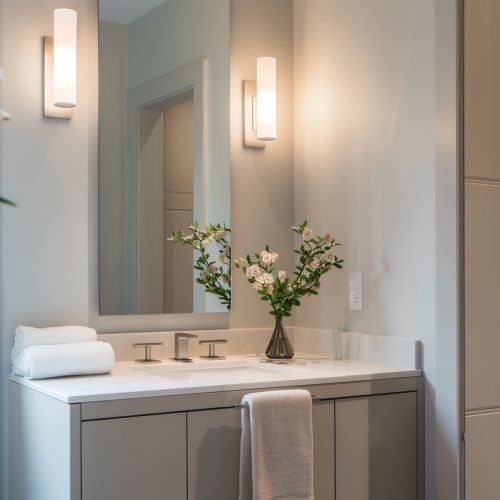
Plain Plain bathroom mirrors are a staple in modern bathroom design, known for their minimalist aesthetic and functional benefits. This section provides an in-depth look at their importance in enhancing bathroom spaces, their historical evolution, and key features that make them a popular choice. Whether you're renovating or updating your bathroom, understanding these aspects will help you make informed decisions about incorporating Plain Plain bathroom mirrors into your decor.
Overview of Plain Bathroom Mirrors
Plain Plain bathroom mirrors are an essential fixture in modern bathrooms, offering both functional and aesthetic benefits. These mirrors come in various shapes and sizes, typically without ornate frames, focusing on simplicity and utility. Their minimalist design makes them versatile, suitable for various bathroom styles from contemporary to traditional. Plain bathroom mirrors enhance the sense of space by reflecting light and creating an illusion of a larger room. They are particularly popular in small bathrooms where maximizing space and light is crucial. Additionally, these mirrors serve practical purposes for daily routines such as grooming, applying makeup, and shaving. With a focus on clean lines and clear reflections, Plain Plain bathroom mirrors are a fundamental component in bathroom design, ensuring both style and functionality.
Importance in Bathroom Design
The importance of plain bathroom mirrors in bathroom design cannot be overstated. They play a critical role in enhancing the visual appeal and functionality of the space. Mirrors reflect light, both natural and artificial, brightening the room and making it feel more spacious. This is especially beneficial in smaller bathrooms where light and space are at a premium. Furthermore, mirrors serve as a focal point in bathroom design, adding depth and dimension. Strategically placed mirrors can highlight architectural features, decorative elements, and other design aspects of the bathroom. Beyond aesthetics, Plain Plain bathroom mirrors are essential for daily grooming activities, providing a clear and unobstructed view for tasks such as shaving, makeup application, and hairstyling. Overall, their role in bathroom design is multifaceted, combining practical utility with aesthetic enhancement.
History and Evolution of Bathroom Mirrors
The history and evolution of bathroom mirrors reflect advancements in technology and changes in design preferences. Ancient civilizations, including the Egyptians and Greeks, used polished metal surfaces as mirrors. These early mirrors were limited in size and clarity. The invention of glass-blowing techniques in the Roman era marked a significant advancement, allowing for larger and clearer mirrors. During the Renaissance, Venice became renowned for its high-quality glass mirrors, which were luxury items for the wealthy. The Industrial Revolution brought further advancements, making mirrors more affordable and accessible to the general public. In contemporary times, bathroom mirrors have evolved to incorporate features such as anti-fog coatings, integrated lighting, and magnification, enhancing both their functionality and aesthetic appeal. Today, plain bathroom mirrors are designed to be sleek and modern, fitting seamlessly into various bathroom styles while offering enhanced practicality.
Key Features of Plain Bathroom Mirrors
Plain bathroom mirrors are characterized by several key features that make them a popular choice for modern bathrooms. One of the primary features is their minimalist design, which typically lacks ornate frames, focusing on simplicity and clean lines. This design versatility allows them to blend seamlessly into any bathroom decor, from contemporary to traditional. Another key feature is their reflective quality, which enhances light and creates an illusion of space, making bathrooms appear larger and brighter. Plain Plain bathroom mirrors are also often designed with durability in mind, using high-quality glass that resists fogging and corrosion, ensuring longevity in a humid environment. Additionally, these mirrors may include functional enhancements such as built-in lighting, magnification options, and anti-fog features, providing added convenience for daily grooming tasks. Overall, the key features of plain bathroom mirrors combine aesthetic appeal with practical functionality, making them an essential element in bathroom design.
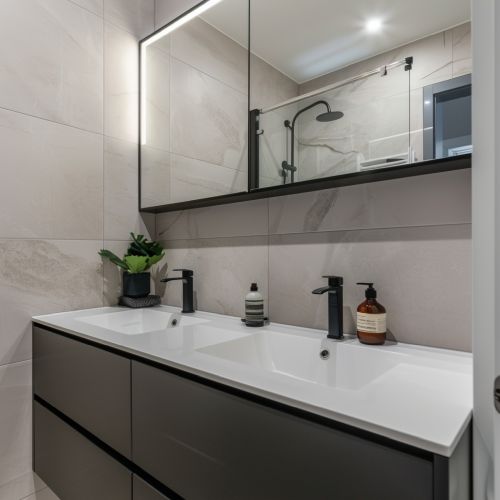
Plain bathroom mirrors offer a range of advantages that make them a popular choice for both aesthetic and functional reasons. This section explores the various benefits these mirrors provide, including their ability to enhance lighting, create an illusion of space, serve essential functional purposes, add aesthetic appeal, and offer versatile design options. Understanding these benefits can help you make an informed decision when selecting the perfect mirror for your bathroom, ensuring it meets both your practical needs and design preferences. Read on to discover how Plain Plain bathroom mirrors can transform your bathroom into a brighter, more spacious, and stylish environment.
Enhanced Lighting
Plain bathroom mirrors are excellent for enhancing lighting in your bathroom. By reflecting both natural and artificial light, they help to brighten up the space, making it feel more inviting and open. This is particularly beneficial in bathrooms with limited natural light or small windows. A well-placed mirror can effectively bounce light around the room, reducing the need for additional lighting fixtures and saving on energy costs. Enhanced lighting not only improves the functionality of the space but also contributes to a more cheerful and pleasant ambiance, perfect for starting your day. For optimal results, position your mirror opposite or adjacent to a light source to maximize this benefit.
Illusion of Space
One of the primary benefits of plain bathroom mirrors is their ability to create an illusion of space. In smaller bathrooms, mirrors can make the area appear larger and more open by reflecting the room's dimensions and light. This visual trick is especially useful in compact spaces, where every inch matters. By placing a large mirror on one wall, you can double the visual depth of the room, making it feel much more spacious and less confined. This technique is widely used in interior design to enhance the perceived size of any room, making Plain Plain bathroom mirrors a valuable addition to small bathrooms.
Functional Use
Plain bathroom mirrors are not just for show; they serve crucial functional purposes in daily routines. Essential for grooming tasks such as shaving, makeup application, and hairstyling, a clear and well-placed mirror ensures you can perform these activities with precision and ease. Having a good-quality mirror in your bathroom helps streamline your morning and evening routines, providing a reliable surface for close inspection and detailed work. Additionally, functional mirrors can be paired with magnifying options for tasks that require even more precision. Ensuring your bathroom mirror meets your functional needs is key to maintaining an efficient and effective grooming space.
Aesthetic Appeal
The aesthetic appeal of plain bathroom mirrors lies in their simplicity and versatility. Their minimalist design can seamlessly blend with any bathroom decor, whether modern, contemporary, or traditional. A plain mirror provides a clean and uncluttered look, enhancing the overall design without overwhelming other decorative elements. This simplicity allows for greater flexibility in styling, as the mirror can complement a wide range of color schemes and materials. By choosing a plain bathroom mirror, you add a touch of elegance and sophistication to your space, ensuring it remains timeless and stylish for years to come.
Versatile Design
Plain bathroom mirrors offer versatile design options that can adapt to various styles and preferences. Available in numerous shapes and sizes, these mirrors can be customized to fit any bathroom layout. Whether you prefer a large rectangular mirror to make a statement or a small round mirror for a subtle touch, the options are endless. The frameless design of plain mirrors adds to their versatility, as they can blend seamlessly with different types of decor, from sleek modern designs to more classic or rustic styles. This adaptability makes Plain Plain bathroom mirrors a popular choice for those looking to personalize their bathroom space.
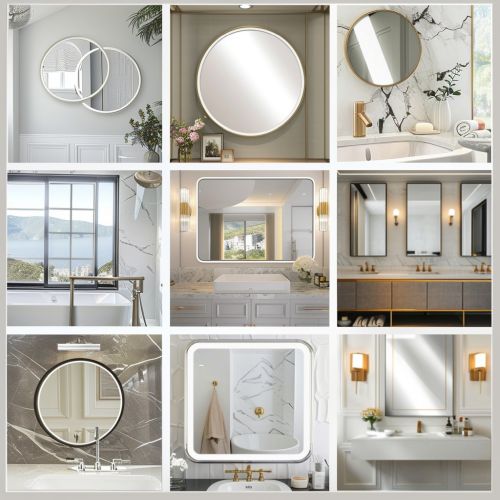
Plain bathroom mirrors come in various types, each offering unique features and benefits. This section provides a detailed look at different types of plain bathroom mirrors, including frameless, framed, pivot, lighted, and magnifying mirrors. Understanding these types will help you choose the best mirror to meet your functional needs and aesthetic preferences. Read on to discover the diverse options available for Plain Plain bathroom mirrors.
Frameless Mirrors
Frameless mirrors are a popular choice for modern bathrooms due to their sleek and minimalist design. Without a frame, these mirrors provide a clean and uncluttered look that can make a space appear larger and more open. Frameless mirrors are versatile and can be mounted directly on the wall or incorporated into vanity setups. They are easy to clean and maintain, as there are no frames to collect dust or moisture. Additionally, frameless mirrors can blend seamlessly with any bathroom decor, from contemporary to traditional styles, making them a flexible choice for various design preferences.
Framed Mirrors
Framed mirrors add a touch of elegance and personality to your bathroom. Available in a wide range of materials, such as wood, metal, and plastic, framed mirrors can complement different design themes and enhance the overall decor. The frame can be simple and understated or ornate and decorative, depending on your aesthetic preferences. Framed mirrors provide additional structural support and can be easier to hang, especially for larger mirrors. They also offer an opportunity to introduce color and texture to your bathroom, making them a focal point in the room's design.
Pivot Mirrors
Pivot mirrors are mounted on adjustable pivots that allow the mirror to tilt and swivel. This feature provides flexibility in positioning, making it easier to find the perfect angle for grooming tasks. Pivot mirrors are particularly useful in shared bathrooms, where users of different heights can adjust the mirror to their preference. These mirrors often come in frameless or minimally framed designs, maintaining a sleek and modern appearance. The functionality and versatility of pivot mirrors make them a practical addition to any bathroom, enhancing both convenience and style.
Lighted Mirrors
Lighted mirrors come with built-in lighting, providing enhanced illumination for grooming tasks. These mirrors often feature LED lights around the edges or behind the mirror, offering even and shadow-free lighting. Lighted mirrors are ideal for bathrooms with insufficient natural light or for individuals who need precise lighting for makeup application, shaving, or hairstyling. They can also add a modern and luxurious touch to your bathroom decor. Many lighted mirrors come with additional features, such as dimmable lights, touch controls, and anti-fog capabilities, making them a functional and stylish choice for contemporary bathrooms.
Magnifying Mirrors
Magnifying mirrors are designed to provide a close-up view, making them ideal for detailed grooming tasks such as makeup application, shaving, and skincare routines. These mirrors typically offer magnification levels ranging from 2x to 10x, allowing you to see fine details clearly. Magnifying mirrors can be wall-mounted, countertop, or integrated into larger bathroom mirrors. Some models feature adjustable arms and swivel functions for added convenience. The clarity and precision provided by magnifying mirrors make them an essential tool in any bathroom, ensuring you can perform grooming tasks with accuracy and ease.
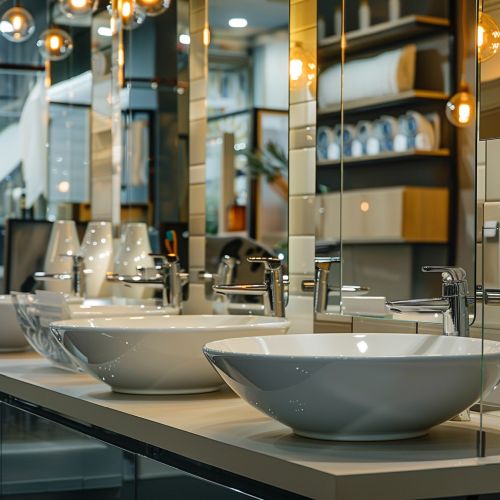
When choosing a bathroom mirror, several key factors should be considered to ensure it meets both your aesthetic and functional needs. This section covers important design considerations such as size, shape, frame material, mounting style, and lighting. By understanding these factors, you can select the perfect mirror to enhance your bathroom's look and usability.
Size
The size of your bathroom mirror should be proportional to the size of your vanity and overall bathroom space. A larger mirror can create an illusion of space and brighten up the room by reflecting more light. However, in smaller bathrooms, a smaller mirror may be more appropriate to maintain balance and avoid overwhelming the space. Consider the width of your vanity and ensure the mirror is either the same width or slightly smaller for a cohesive look. The height of the mirror should also provide a clear view for all users, typically extending from the sink to a few inches above eye level.
Shape
The shape of your bathroom mirror can significantly impact the room's aesthetic. Common shapes include rectangular, square, round, and oval. Rectangular and square mirrors offer a classic and versatile look, suitable for most bathroom styles. Round and oval mirrors add a softer, more modern touch and can help break up the straight lines typically found in bathroom fixtures. The shape you choose should complement the overall design theme of your bathroom and enhance its visual appeal. Experiment with different shapes to find the one that best fits your space and personal style.
Frame Material
The material of the mirror frame can influence both its appearance and durability. Wood frames add warmth and can complement traditional or rustic bathroom designs. Metal frames offer a sleek and contemporary look, ideal for modern and industrial styles. Plastic frames are versatile and come in various finishes, making them a budget-friendly option. Consider the existing materials and finishes in your bathroom when selecting a frame material to ensure a cohesive look. Additionally, choose materials that can withstand the humid environment of a bathroom to ensure longevity.
Mounting Style
The mounting style of your bathroom mirror affects its functionality and ease of installation. Wall-mounted mirrors are the most common and can be easily installed above the vanity. Recessed mirrors are embedded into the wall, providing a flush, streamlined look but requiring more complex installation. Surface-mounted mirrors are easier to install and can add depth to the room. Consider the layout of your bathroom and the available wall space when choosing a mounting style. Ensure the mounting style you select provides both aesthetic appeal and practical usability.
Lighting
Proper lighting is essential for bathroom mirrors to ensure clear visibility for grooming tasks. Integrated lighting options, such as LED-lit mirrors, provide even and shadow-free illumination, ideal for makeup application, shaving, and skincare routines. Positioning your mirror near a light source or installing sconces on either side can also enhance lighting. Consider the color temperature of the lights to create a flattering and functional environment. Natural light is beneficial, so if possible, place the mirror to reflect natural light from windows. Good lighting not only improves functionality but also adds to the overall ambiance of the bathroom.
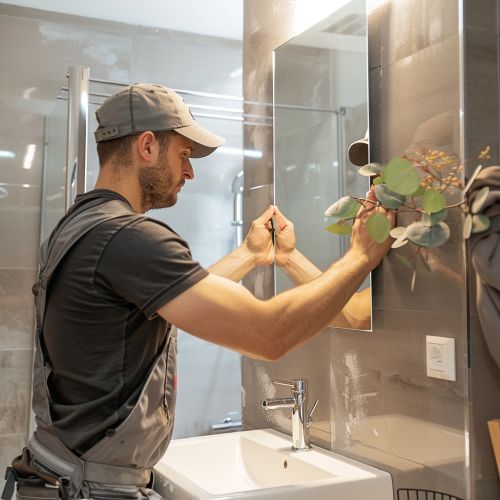
Option 1: Hanging
Installing a plain bathroom mirror requires careful planning and the right tools to ensure a secure and professional fit. This section provides step-by-step instructions for installing plain bathroom mirrors, including the necessary tools and tips for a successful installation. Follow these guidelines to properly install your bathroom mirror and enhance your bathroom space.
Tools and Materials Needed
Before you begin the installation, gather the necessary tools and materials:
- Measuring tape
- Pencil
- Level
- Drill and appropriate drill bits
- Wall anchors and screws
- Screwdriver
- Mirror adhesive (optional)
- Protective gloves and goggles
Step 1: Measure and Mark
Start by measuring the area where you want to install the mirror. Use a pencil and level to mark the desired position on the wall. Ensure the markings are level to avoid a crooked installation. Measure twice to confirm accuracy, and consider the height and placement relative to your vanity and lighting fixtures.
Step 2: Install Wall Anchors
Drill pilot holes at the marked locations for the wall anchors. The type of wall anchors you use will depend on your wall material (drywall, plaster, etc.). Insert the wall anchors into the holes, ensuring they are flush with the wall surface. Wall anchors provide the necessary support to hold the mirror securely.
Step 3: Attach Mounting Hardware
Next, attach the mounting hardware to the back of the mirror. This may include D-rings, brackets, or a wire. If your mirror is particularly heavy, use additional mounting hardware for added security. Follow the manufacturer’s instructions for the specific hardware included with your mirror.
Step 4: Hang the Mirror
Carefully align the mirror with the wall anchors and attach it securely. If using mirror adhesive, apply it to the back of the mirror before positioning it on the wall. Ensure the mirror is level and pressed firmly against the wall. If using screws, insert them through the mounting hardware into the wall anchors and tighten with a screwdriver.
Step 5: Final Adjustments
Once the mirror is securely in place, make any final adjustments to ensure it is level and stable. Double-check all screws and mounting hardware to confirm everything is tightened properly. Clean the mirror surface to remove any fingerprints or smudges from the installation process. Your plain bathroom mirror is now installed and ready to enhance your bathroom space.
Option 2: Mirror Adhesive
Installing a plain bathroom mirror with adhesive requires careful preparation and the right tools to ensure a secure fit. This section provides step-by-step instructions for using mirror adhesive, including the necessary tools and tips for a successful installation. Follow these guidelines to properly install your bathroom mirror and enhance your bathroom space.
Tools and Materials Needed
Before you begin the installation, gather the necessary tools and materials:
- Measuring tape
- Pencil
- Level
- Mirror adhesive
- Caulking gun
- Painter's tape
- Protective gloves and goggles
Step 1: Measure and Mark
Start by measuring the area where you want to install the mirror. Use a pencil and level to mark the desired position on the wall. Ensure the markings are level to avoid a crooked installation. Measure twice to confirm accuracy, and consider the height and placement relative to your vanity and lighting fixtures.
Step 2: Prepare the Wall and Mirror
Clean the wall surface thoroughly to remove any dust, dirt, or grease. Similarly, clean the back of the mirror where the adhesive will be applied. Ensuring both surfaces are clean will improve adhesion and ensure a secure fit.
Step 3: Apply the Adhesive
Using a caulking gun, apply the mirror adhesive to the back of the mirror in evenly spaced vertical line approximately 10cm apparat and 5-10mm thick. Be sure to follow the adhesive manufacturer's instructions for application. Avoid placing adhesive too close to the edges to prevent it from oozing out when the mirror is pressed against the wall.
Step 4: Position and Secure the Mirror
Carefully align the mirror with the marks on the wall and press it firmly into place. Hold the mirror in position for a few minutes to allow the adhesive to bond. Use painter's tape to temporarily secure the mirror to the wall while the adhesive cures, following the adhesive manufacturer's recommended curing time.
Step 5: Final Adjustments
Once the adhesive has fully cured, remove the painter's tape and check the mirror for stability. Clean the mirror surface to remove any fingerprints or smudges from the installation process. Your bathroom mirror is now installed and ready to enhance your bathroom space.
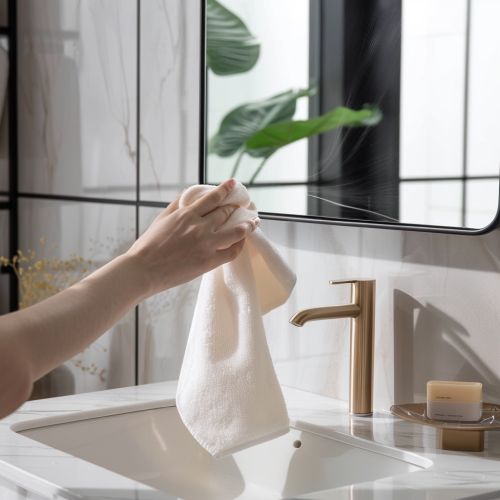
Maintaining your bathroom mirror involves regular cleaning and preventative measures to ensure it remains in excellent condition. This section provides best practices for keeping your bathroom mirror clean and well-maintained, including effective cleaning techniques and damage prevention tips. Follow these guidelines to preserve the clarity and longevity of your bathroom mirror.
Regular Cleaning
To keep your bathroom mirror sparkling clean, use a high-quality glass cleaner and a soft, lint-free cloth or microfiber cloth. Spray the cleaner onto the cloth rather than directly onto the mirror to avoid streaks. Wipe the mirror in a circular motion or use a vertical/horizontal pattern to ensure thorough cleaning. Avoid using abrasive sponges or harsh chemicals, as these can scratch or damage the mirror's surface.
Preventing Moisture Damage
Bathrooms are typically high-moisture environments, which can lead to mirror damage over time. To prevent this, ensure proper ventilation in your bathroom by using an exhaust fan or opening windows during and after showers. Wipe down the mirror with a dry cloth to remove any moisture buildup. For added protection, consider using an anti-fog spray or a mirror defogger to minimize moisture accumulation on the mirror's surface.
Avoiding Scratches
Scratches can mar the appearance of your bathroom mirror and reduce its effectiveness. To avoid scratches, never use abrasive materials or scouring pads on the mirror. When cleaning, use soft cloths and gentle cleaning solutions. If your mirror is framed, take care when cleaning the frame to avoid inadvertently scratching the glass. Handle the mirror with care during installation and any maintenance activities to prevent accidental damage.
Checking Mounting Hardware
Periodically check the mounting hardware to ensure the mirror remains securely attached to the wall. Loose hardware can cause the mirror to tilt or fall, potentially resulting in damage or injury. Tighten any loose screws or brackets and replace any damaged hardware as needed. Regularly inspecting the mounting hardware helps maintain the mirror's stability and safety.
Addressing Damage Promptly
If your bathroom mirror develops chips, cracks, or other damage, it is important to address it promptly to prevent further deterioration. Unfortunately, bathroom mirrors typically cannot be effectively repaired once damaged due to the nature of their construction and reflective coating. Chips and cracks can compromise the mirror's integrity and clarity, leading to safety hazards and decreased functionality. The reflective coating on the back of the mirror is very delicate and any damage to it cannot be restored to its original condition. For these reasons, it is usually necessary to replace the damaged mirror entirely. Replacing the mirror ensures that you maintain a clear, safe, and aesthetically pleasing bathroom space. Prompt attention to damage helps extend the life of your mirror setup and ensures it continues to function effectively.
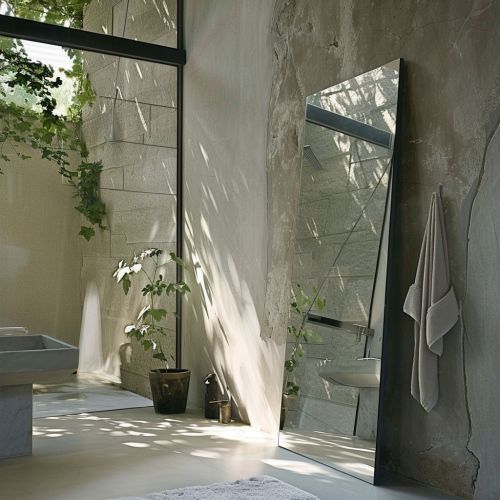
Choosing the right mirror for your bathroom involves considering various factors to ensure it complements your space and meets your functional needs. This section offers advice on selecting the perfect mirror for different bathroom sizes and styles, helping you enhance both the aesthetics and utility of your bathroom.
Assessing Bathroom Size
The size of your bathroom plays a crucial role in mirror selection. For smaller bathrooms, choose mirrors that maximize the sense of space, such as large, frameless mirrors that reflect more light and create the illusion of a bigger area. In larger bathrooms, you have the flexibility to choose more substantial mirrors or even multiple mirrors to add depth and interest. Ensure the mirror is proportionate to your vanity size, ideally the same width or slightly narrower.
Matching Bathroom Style
Your mirror should complement the overall style of your bathroom. For modern bathrooms, opt for sleek, frameless mirrors or mirrors with minimalistic frames in metallic finishes. Traditional bathrooms benefit from ornate, framed mirrors with classic designs. If your bathroom has a rustic or farmhouse style, consider wooden frames that add warmth and texture. The mirror’s design should seamlessly integrate with the existing decor to enhance the room's cohesive look.
Considering Functionality
Functionality is key when selecting a bathroom mirror. Consider mirrors with integrated lighting for better illumination during grooming tasks. Magnifying mirrors are useful for tasks requiring close-up detail, such as makeup application or shaving. Pivot mirrors that tilt are ideal for households with users of different heights. Think about the daily activities in your bathroom and choose a mirror that best supports these tasks.
Choosing the Right Shape
The shape of your mirror can significantly impact the aesthetic of your bathroom. Rectangular and square mirrors offer a classic and versatile look suitable for most styles. Round and oval mirrors add a softer, more contemporary touch and can break up the straight lines of other bathroom fixtures. Irregular or geometric shapes can make a bold statement and serve as a focal point in the room. Choose a shape that complements the overall design and meets your visual preferences.
Evaluating Frame Material
The material of the mirror frame contributes to both its durability and aesthetic appeal. Wooden frames add warmth and are ideal for rustic or traditional styles. Metal frames offer a sleek, modern look and are durable, making them suitable for contemporary bathrooms. Plastic frames are versatile and come in various finishes, providing a budget-friendly option. Consider the humidity in your bathroom and choose materials that can withstand moisture to ensure longevity.
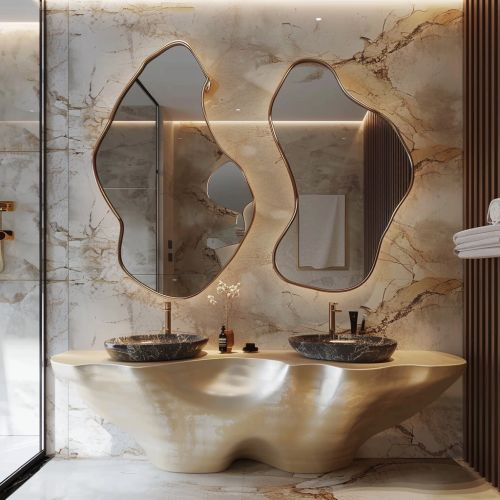
Integrating plain bathroom mirrors into your overall bathroom decor can significantly enhance the space’s aesthetic and functionality. This section provides tips on how to seamlessly incorporate these mirrors into your bathroom design, ensuring a cohesive and stylish look.
Creating a Focal Point
One of the most effective ways to incorporate a mirror into your bathroom decor is by making it a focal point. Choose a large, frameless mirror or a uniquely shaped mirror that draws attention. Position it above the vanity to naturally catch the eye and reflect the room’s best features. Adding lighting around the mirror can further enhance its prominence and create a striking visual effect.
Enhancing Natural Light
Mirrors are excellent tools for enhancing natural light in your bathroom. Place a mirror opposite a window to maximize light reflection and brighten the space. This technique not only improves the room’s ambiance but also makes it appear larger and more inviting. If your bathroom lacks natural light, consider positioning the mirror near artificial light sources to achieve a similar effect.
Complementing Bathroom Fixtures
Ensure that your mirror complements other bathroom fixtures and fittings. If you have brushed nickel faucets and showerheads, choose a mirror with a matching frame. For a cohesive look, coordinate the mirror’s style with other elements such as towel racks, light fixtures, and cabinetry hardware. This attention to detail helps create a unified and polished bathroom design.
Layering with Other Decorative Elements
Layering mirrors with other decorative elements can add depth and interest to your bathroom decor. Consider placing smaller, decorative mirrors alongside artwork or shelving to create a gallery wall effect. You can also use mirrors to reflect and amplify other design features, such as plants, vases, or decorative tiles, adding complexity and richness to the space.
Utilizing Mirror Placement Strategically
Strategic placement of mirrors can enhance the functionality and aesthetic of your bathroom. For instance, placing a full-length mirror on a door or a wall can provide practical benefits while also making the room feel taller. Similarly, adding mirrors to recessed areas or alcoves can highlight architectural details and add dimension. Think about the most advantageous placements to maximize both form and function in your bathroom.
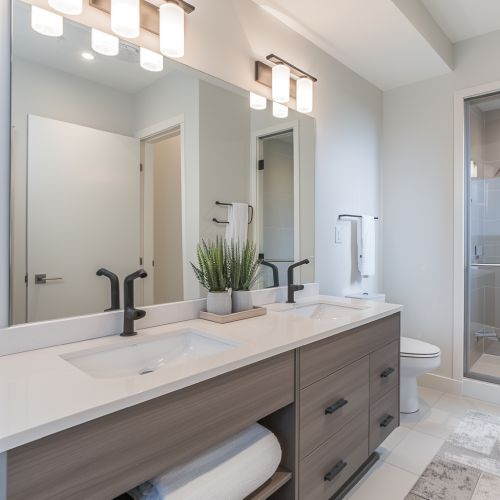
The cost of plain bathroom mirrors can vary widely depending on several factors, including size, material, design, and additional features. This section provides information on the cost range of plain bathroom mirrors, factors influencing their pricing, and tips for budgeting to help you make an informed decision.
Cost Range
Plain Plain bathroom mirrors typically range in price from as low as £30 for small, basic models to over $500 for large, high-end designs. Budget-friendly options include frameless mirrors and simple framed mirrors, which are perfect for minimalistic bathroom designs. Mid-range mirrors, costing between £50 and £250, often feature higher-quality glass and more decorative frames. High-end mirrors, priced at £250 and above, may include features like built-in lighting, anti-fog technology, and premium materials.
Factors Influencing Pricing
Several factors can influence the pricing of plain bathroom mirrors:
- **Size**: Larger mirrors require more materials and labor, resulting in higher costs.
- **Material**: Mirrors with premium materials such as beveled edges, high-quality glass, or decorative frames are more expensive.
- **Design**: Custom or designer mirrors with unique shapes or intricate designs tend to be pricier.
- **Features**: Additional features like integrated lighting, anti-fog capabilities, and magnification can increase the cost significantly.
- **Brand**: Well-known brands often command higher prices due to their reputation for quality and design.
Budgeting Tips
When budgeting for a bathroom mirror, consider the following tips to get the best value for your money:
- **Determine Your Needs**: Assess your requirements for size, design, and features to avoid overspending on unnecessary extras.
- **Compare Prices**: Shop around and compare prices from different retailers to find the best deals.
- **Look for Sales**: Take advantage of sales and discounts, especially during holiday seasons or store promotions.
- **Consider DIY Options**: If you're on a tight budget, consider purchasing a basic mirror and adding your own frame or decorative elements.
- **Invest in Quality**: While it might be tempting to opt for the cheapest option, investing in a higher-quality mirror can save you money in the long run by reducing the need for replacements or repairs.
How do you install a plain bathroom mirror?
Installing a plain bathroom mirror involves several steps: First, measure and mark the desired position on the wall. Use a level to ensure accuracy. Depending on the mirror's size and weight, you may need wall anchors and screws for secure mounting. Apply mirror adhesive to the back of the mirror or use mounting hardware such as brackets or D-rings. Carefully position the mirror on the wall and press firmly. For larger mirrors, additional support may be necessary until the adhesive sets. Ensure everything is level and stable before finalizing the installation.
What are plain bathroom mirrors?
Plain bathroom mirrors are simple, unadorned mirrors typically used in bathrooms for their functionality and minimalist aesthetic. They come in various shapes and sizes, often without elaborate frames or decorative elements. These mirrors are designed to be versatile, fitting seamlessly into a variety of bathroom styles from modern to traditional. Their primary function is to provide a clear reflection for grooming and personal care tasks.
What are the benefits of plain bathroom mirrors?
Plain Plain bathroom mirrors offer numerous benefits including enhanced lighting by reflecting natural and artificial light, creating an illusion of more space, and providing essential functionality for daily grooming tasks. Their minimalist design allows them to blend with various bathroom styles, adding to their versatility. Additionally, plain mirrors are often more affordable and easier to maintain than their decorative counterparts.
Can plain bathroom mirrors be customized?
Yes, plain bathroom mirrors can be customized to fit your specific needs and preferences. Customization options include choosing the size and shape of the mirror, adding beveled edges, or selecting a unique frame material and color. Some mirrors can also be fitted with additional features such as integrated lighting, anti-fog coatings, or magnification. Customizing your mirror allows you to create a look that perfectly complements your bathroom decor and functional requirements.
How do you clean a plain bathroom mirror?
To clean a plain bathroom mirror, use a high-quality glass cleaner and a soft, lint-free cloth or microfiber cloth. Spray the cleaner onto the cloth rather than directly onto the mirror to avoid streaks. Wipe the mirror in a circular motion or use vertical/horizontal patterns to ensure thorough cleaning. Avoid abrasive sponges or harsh chemicals that can scratch or damage the mirror's surface. Regular cleaning helps maintain the mirror's clarity and appearance.
What sizes do plain bathroom mirrors come in?
Plain Plain bathroom mirrors come in a wide range of sizes to fit different bathroom layouts and needs. Common sizes include small, medium, and large mirrors. Small mirrors are typically around 16x20 inches, medium mirrors range from 24x30 inches, and large mirrors can be 36x48 inches or larger. Custom sizes are also available to fit specific requirements. When choosing a size, consider the proportions of your vanity and wall space to ensure a balanced look.
Are plain bathroom mirrors suitable for all bathroom styles?
Yes, plain bathroom mirrors are highly versatile and can complement a wide range of bathroom styles. Their simple design allows them to blend seamlessly with contemporary, traditional, minimalist, and eclectic decor. Whether you prefer a sleek frameless mirror for a modern look or a framed mirror with a classic touch, plain bathroom mirrors can be adapted to suit your style preferences while providing essential functionality.
How do plain bathroom mirrors enhance lighting?
Plain bathroom mirrors enhance lighting by reflecting both natural and artificial light, which helps to brighten the space. Positioning a mirror opposite a window can maximize the amount of natural light reflected, making the room feel more open and airy. Additionally, placing mirrors near light sources such as vanity lights or sconces can amplify the illumination, reducing the need for additional lighting fixtures and creating a more inviting atmosphere.
What materials are used for plain bathroom mirrors?
Plain bathroom mirrors are typically made from high-quality glass with a reflective coating applied to the back. The glass is often treated to be shatter-resistant and may have beveled edges for a polished finish. Frames, if present, can be made from various materials such as wood, metal, or plastic, each offering different aesthetic and functional benefits. Frameless mirrors are also common, providing a sleek, modern look without additional materials.
Can plain bathroom mirrors be used in other rooms?
Yes, plain bathroom mirrors can be used in other rooms beyond the bathroom. Their simple, versatile design makes them suitable for various spaces such as bedrooms, living rooms, hallways, and entryways. In bedrooms, they can be used as vanity mirrors or full-length mirrors for dressing. In living rooms, they can enhance the sense of space and light. Hallways and entryways benefit from mirrors to create a welcoming atmosphere and provide a last-minute check before leaving the house. The adaptability of plain bathroom mirrors allows them to complement different styles and functions throughout your home.
Are plain bathroom mirrors easy to install?
Yes, plain bathroom mirrors are generally easy to install, especially with the right tools and instructions. Most mirrors come with mounting hardware such as brackets, screws, or adhesive options. For lighter mirrors, adhesive strips or mirror glue can be used. Heavier mirrors may require wall anchors and additional support. It's important to measure and mark the wall accurately before installation to ensure the mirror is level. Following the manufacturer's instructions and using appropriate tools will help achieve a secure and professional installation.
What shapes are available for plain bathroom mirrors?
Plain bathroom mirrors come in a variety of shapes to suit different aesthetic preferences and functional needs. Common shapes include rectangular, square, round, and oval mirrors. Rectangular and square mirrors are versatile and can fit into most bathroom designs. Round and oval mirrors add a softer, more elegant touch and are often used to create a focal point. Additionally, there are custom and geometric shapes available for a unique, personalized look. The shape you choose should complement the overall design and layout of your bathroom.
How do I safely remove mirror walls and mirror tiles from a wall or surface?
To safely remove mirror walls and mirror tiles from a wall or surface, start by using protective gloves and eye wear to prevent injury from broken glass. Use safety backing film over the face of the mirror, to avoid loose pieces falling away. Use a putty knife or similar tool to loosen the adhesive or hardware holding the mirrors in place, and gently lift the mirrors away from the wall or surface. This process can take sometime and should not be rushed. Be sure to dispose of the mirrors safely and in accordance with local regulations.
How do plain bathroom mirrors compare to decorative mirrors?
Plain bathroom mirrors are typically simpler and more minimalist compared to decorative mirrors. They focus on functionality and versatility, making them suitable for various bathroom styles. Decorative mirrors, on the other hand, often feature ornate frames, unique shapes, and additional design elements that make them stand out as focal points. While plain mirrors are generally more affordable and easier to match with different decors, decorative mirrors add a touch of elegance and personality to the space. The choice between the two depends on your aesthetic preferences and the overall design of your bathroom.
What features should I look for in a plain bathroom mirror?
When selecting a plain bathroom mirror, consider features such as size, shape, frame material (if applicable), and additional functionalities. Size should be proportionate to your vanity and wall space. Shape should complement your bathroom's design. For frames, materials like wood, metal, or plastic can offer different aesthetic and durability benefits. Additional features to look for include integrated lighting, anti-fog coatings, magnification options, and ease of installation. These features can enhance the mirror's functionality and overall appeal in your bathroom.
How do I prevent my plain bathroom mirror from fogging up?
To prevent your plain bathroom mirror from fogging up, you can use several methods. Anti-fog sprays and coatings can be applied to the mirror surface to reduce fogging. Another option is to install a heated mirror pad behind the mirror, which warms the glass and prevents condensation. Good ventilation is also crucial; ensure your bathroom has an exhaust fan or open windows during and after showers to reduce humidity. Additionally, wiping the mirror with a mixture of water and vinegar or a small amount of shampoo can create a temporary anti-fog barrier.
Are plain bathroom mirrors durable?
Yes, plain bathroom mirrors are generally durable, especially when made from high-quality materials. The glass used in bathroom mirrors is often treated to be shatter-resistant and can withstand the humid environment of a bathroom. However, it's essential to avoid harsh chemicals or abrasive materials that can scratch or damage the mirror surface. Proper installation and regular maintenance can also extend the lifespan of your bathroom mirror. Choosing a mirror with a durable frame material, such as metal or treated wood, can further enhance its longevity.
Can plain bathroom mirrors be frameless?
Yes, plain bathroom mirrors can be frameless, offering a sleek and modern look that fits well with contemporary bathroom designs. Frameless mirrors are usually mounted with brackets or adhesive, creating a clean, uncluttered appearance. They are available in various shapes and sizes, providing flexibility in design and installation. The lack of a frame makes them easy to clean and maintain, and their minimalist style allows them to blend seamlessly with any decor.
What are the installation options for plain bathroom mirrors?
There are several installation options for plain bathroom mirrors, including using adhesive, mounting brackets, or mirror clips. Adhesive installation involves applying mirror glue or double-sided tape to the back of the mirror and pressing it firmly against the wall. Mounting brackets, often used for heavier mirrors, involve attaching brackets to the wall and then securing the mirror onto the brackets. Mirror clips are another option, where clips are screwed into the wall, and the mirror is slid into place. Each method has its own advantages, and the best choice depends on the size, weight, and location of the mirror.
Do plain bathroom mirrors require special maintenance?
Plain bathroom mirrors do not require special maintenance but benefit from regular cleaning and proper care to maintain their appearance and functionality. Use a high-quality glass cleaner and a soft, lint-free cloth to wipe the mirror clean, avoiding abrasive materials that can scratch the surface. Ensure the mirror and the surrounding area are dry to prevent moisture damage. Periodically check the mounting hardware to ensure the mirror remains securely attached to the wall. Avoid harsh chemicals that can damage the reflective coating and use anti-fog sprays if fogging is a common issue.
How do I choose the right size mirror for my bathroom?
Choosing the right size mirror for your bathroom depends on the size of your vanity and the wall space available. Ideally, the mirror should be as wide as or slightly narrower than your vanity to create a balanced look. For single vanities, a mirror width of 24-36 inches is common, while double vanities may require mirrors 48 inches or wider. Consider the height of the mirror as well, ensuring it provides a clear view for all users and complements the overall proportions of the room. Custom-sized mirrors are also an option if standard sizes do not fit your space perfectly.